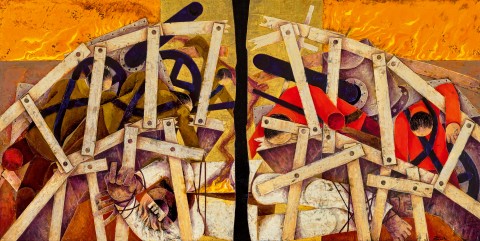THE BRIDGE, 1983
LEONARD FRENCH
enamel on hessian on composition board
122.5 x 244.0 cm
signed lower right: French
inscribed on artist’s label verso: 1983 / Study for the Oppenheimer Mural / Brenthurst Library Johannesburg / South Africa
Powell Street Gallery, Melbourne
Joseph Brown Gallery, Melbourne
The Cbus Collection of Australian Art, Melbourne, acquired from the above on 29 May 1990
Leonard French ‘The Bridge’, Powell Street Gallery, Melbourne, 28 September – 17 October 1985 (illus. on exhibition invitation)
The Bus Collection of Australian Art, Wollongong City Gallery, New South Wales, 16 March – 12 April 1992, cat. 58
Morning, Noon and Night, Latrobe Regional Gallery, Victoria, 13 July - 13 October 2019
Leonard French 'The Bridge', Latrobe Regional Gallery, Victoria, 3 November 2018 – 3 March 2019
on long term loan to Latrobe Regional Gallery, Victoria
Nainby, B., Stanhope, Z., and Furlonger, K., The Cbus Collection of Australian Art, in association with Latrobe Regional Gallery, Melbourne, 2009, pp. 130 (illus.), 219
The Bridge, 1982 – 84, mural, 275.0 x 500.0 cm, in the collection of The Brenthurst Library, Johannesburg, South Africa
The following excerpts are from Arnold, M., ‘‘The Bridge’, by Leonard French, Melbourne’, reproduced at https://
www.brenthurst.org.za/the-bridge/
‘By the time he received the commission from Harry Frederick Oppenheimer for The Brenthurst Library, South Africa [for which the present work is the study], French had established a distinctive relationship between form and content, favouring a stylised schema of representation married to themes where opposing forces were distributed in conceptual and visual tension. Leonard French visited South Africa in 1982. The Bridge was generated by his travels and observations at a time when attempts were being made to restructure rather than dismantle the apartheid artifice.
French travelled widely throughout South Africa but The Bridge is not based on a particular place or event and it offers no direct social comment… [Rather] The Bridge is about people… The subject is a synthesis of contradictory and complex sense-experiences, encounters with people from all sectors of the community, and information about South Africa. The assimilated sources are transformed into an image that explores the tension between opposing forces and the literal and metaphorical implications of the concept, ‘bridge’. A bridge is a physical structure erected to afford safe passage over a barrier and its presence directs human beings along a specific route. It may be a transitional phase connecting two conditions and, in this sense, it is a very apt metaphor for the situation in which South Africa found itself as the architects of apartheid attempted to plan new social routes. Since a bridge facilitates movement and manifests human skill at overcoming impediments, its collapse initiates chaos, signifies human fallibility and implies failure of a system. French depicts a bridge that arches across his entire format and is torn asunder in the centre.
French poses his interpretation of the human condition in South Africa in symbolic terms, avoiding the particularisation that is generated by naturalistic detail. The multitudes that crowd the bridge are mechanised forms, people reduced to automata with heads resembling canon mouths. Accompanied by weapons, wagons and crosses the crowd cannot be identified ethnically or historically. The imagery itself is universalised; conflict and disaster are posed in general terms and the situation relates to South Africa only when a non-formal reading of the imagery admits the relevance of the socio-political South African situation to the interpretation…
…The dominant visual metaphor in The Bridge is that of containment, established by the bridge as a structural container and by its separate bolted units which frame and contain sections of the human procession… Symbolically, the bridge structure is also a container. It is formed by wooden units, irregularly shaped crosses which denote the controlling power of church doctrine. Some figures carry crosses, reinforcing the reference to Christianity and its emotive force within society, something which French must have observed in Nationalist government debates about apartheid. Placed against a gold background, the central shattered area of the bridge contrasts strongly with the moody dark-blue sky… In French’s narrative the break in the bridge is the key to his meaning. Topped by flames, the bridge is broken by an organic black form that plunges vertically through the format. Quite literally, ‘Things fall apart; the centre cannot hold.’ Tearing the opposing forces apart and breaking the structure, the black form is – in the context of the South African situation – a forceful reminder of black power.’
